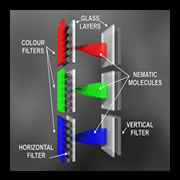
LCD Television

LCD screen color diagram
Liquid Crystal Display (LCD)
A liquid crystal display (LCD) is a display that uses the light modulating properties of liquid crystals (LCs). By applying and electric current to the LCD material, the polarization of light is bent from 0-90 degrees. In order to make LCD TV work, there must be a way to combine the output of vertical and horizontal polarizing filters.
The first vertical polarizing filter blocks all the vertical polarized light and let only the horizontal polarized light pass through. If we apply more electricity to the LCD, the light increases its degree of polarization, and the light can pass through the horizontal polarizing filter. The greater the degree of polarization, the brighter the pixel becomes. Since the LCD cannot produce light by itself, it needs fluorescent back lighting for the light source.
Did you know?
In 1945, There were fewer than 7,000 working TV sets in the country and only nine stations on the air; three in New York, two each in Chicago and Los Angeles, and one each in Philadelphia and Schenectady, N.Y.
